Physical Address
304 North Cardinal St.
Dorchester Center, MA 02124
Optimal specimen handling is essential for the accurate interpretation of biopsies and cytologic preparations obtained in the course of evaluating the patient with lung disease. The limited number of sampling techniques available can be divided into three general categories: bronchoscopy, transthoracic needle core biopsy or aspiration, and surgical wedge biopsy of peripheral lung through a transthoracic approach. ,
The focus of this chapter is on these techniques and the specimens thereby obtained, with emphasis on how they should be prepared and handled in the laboratory. After an appropriate sample of adequate quality has been obtained, the addition of pertinent clinical data and radiologic information greatly increases the likelihood of a meaningful and accurate diagnosis. Even when the diagnostic goal is simply to rule out malignancy, the effect of other information may be substantial, especially when the sample is of marginal quality or size. In the case of diffuse nonneoplastic lung diseases (often referred to as interstitial lung diseases ), a reasonable amount of clinical and radiologic information is essential for accurate interpretation. Without such information, even the experienced lung pathologist may need to resort to a purely descriptive diagnosis.
In this chapter, specimen characteristics and processing steps are presented for each of the common lung samples taken in the course of clinical evaluation for pulmonary disease. In addition, for each type of sample, the benefits and limitations are reviewed. Such a working knowledge of specimen handling for each procedure ensures the greatest likelihood of success in establishing a specific diagnosis and, in the end, a rational treatment plan. An overview of biopsy procedures and the specimens generated is presented in Table 3.1 .
| Sampling Technique | Specimens/Common Analyses |
|---|---|
| Sputum expectoration |
|
| Bronchoscopy with: Washings |
|
| Brushings |
|
| Endobronchial biopsy |
|
| Transbronchial biopsy |
|
| Bronchoalveolar lavage |
|
| Transbronchial fine-needle aspiration and endobronchial ultrasound |
|
| Cryobiopsy |
|
| Surgical “wedge” lung biopsy (either video assisted or open) |
|
| Transthoracic needle core biopsy and aspiration |
|
| Thoracentesis |
|
The flexible bronchoscope was introduced in the United States in the late 1960s, after successful use in Japan. Despite several decades of experience with the rigid bronchoscope, the advent of the flexible bronchoscope ( Fig. 3.1 ) allowed evaluation of the major conducting airways without use of general anesthesia and with less morbidity. , Furthermore, the flexible instrument has the advantage of providing better access to more distal and obliquely branched airways. The rigid bronchoscope still has major uses in certain settings, mainly those in which the device’s larger bore is an advantage, but nowadays pulmonary endoscopy is dominated by the flexible bronchoscope.
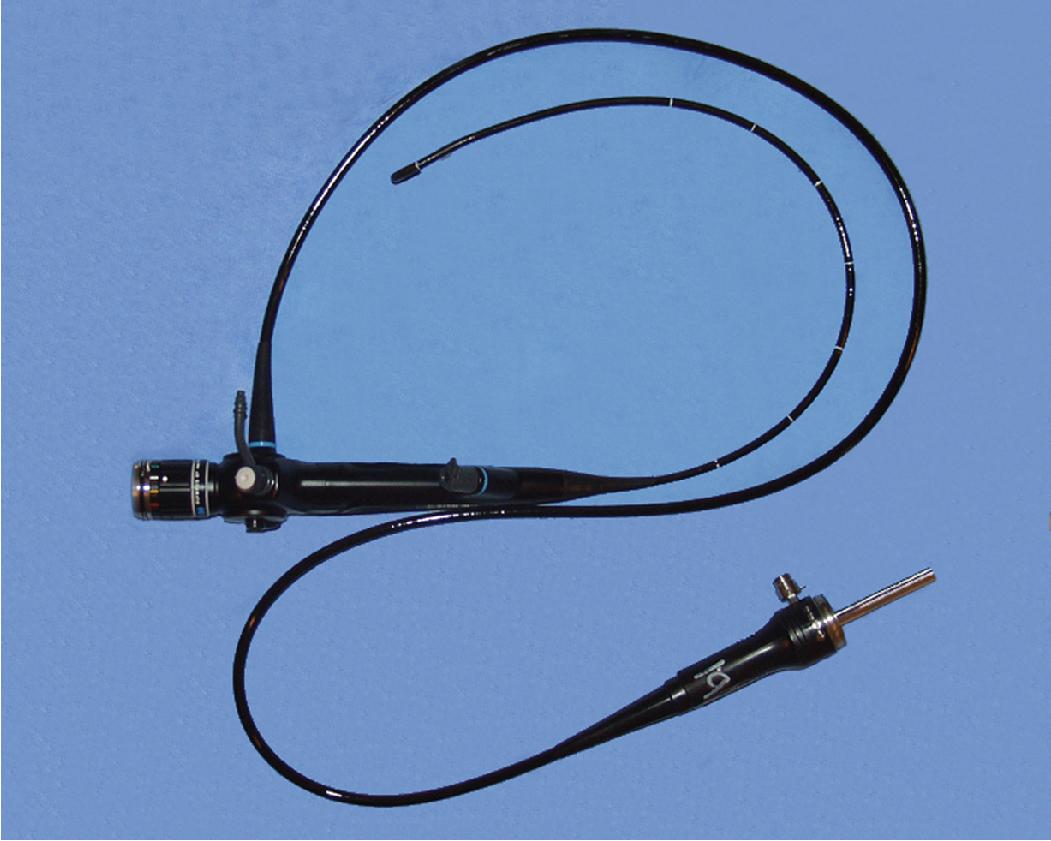
Modern flexible bronchoscopes allow the operator to accurately visualize the structural integrity of the bronchial tree and its mucosal surfaces, commonly as far distal as the sixth-order bronchi , ( Fig. 3.2 ). Biopsy of visualized mucosal lesions most commonly is performed using cupped forceps ( Fig. 3.3 A) introduced through the flexible shaft of the bronchoscope. With this technique, the airway mucosa, lamina propria, and musculature are sampled with or without fragments of cartilage (see Fig. 3.3 B). The closed forceps is extracted from the bronchoscope, and the biopsy is dislodged from the cupped ends of the device and placed in fixative or other solution (see later discussion). A sterile needle or fine-tipped forceps ( Fig. 3.4 ) is useful for removing the delicate tissue specimen. The tissue specimens obtained in this way average 2 to 3 mm in greatest dimension. The lymphovascular network of the peribronchial sheath often is included in these samples, making it possible to identify metastatic disease when present in lymphatic or vascular channels ( Fig. 3.5 ).
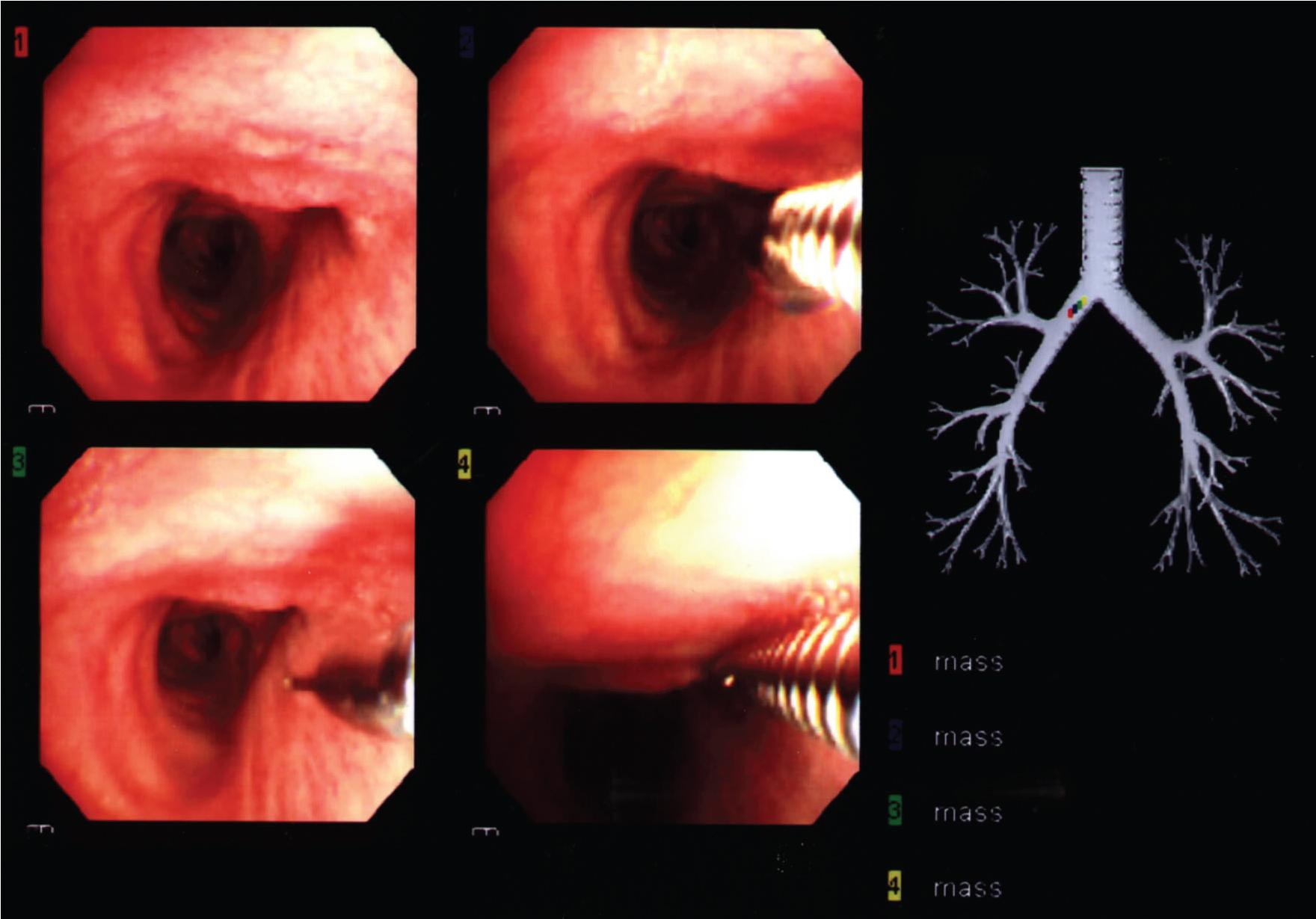
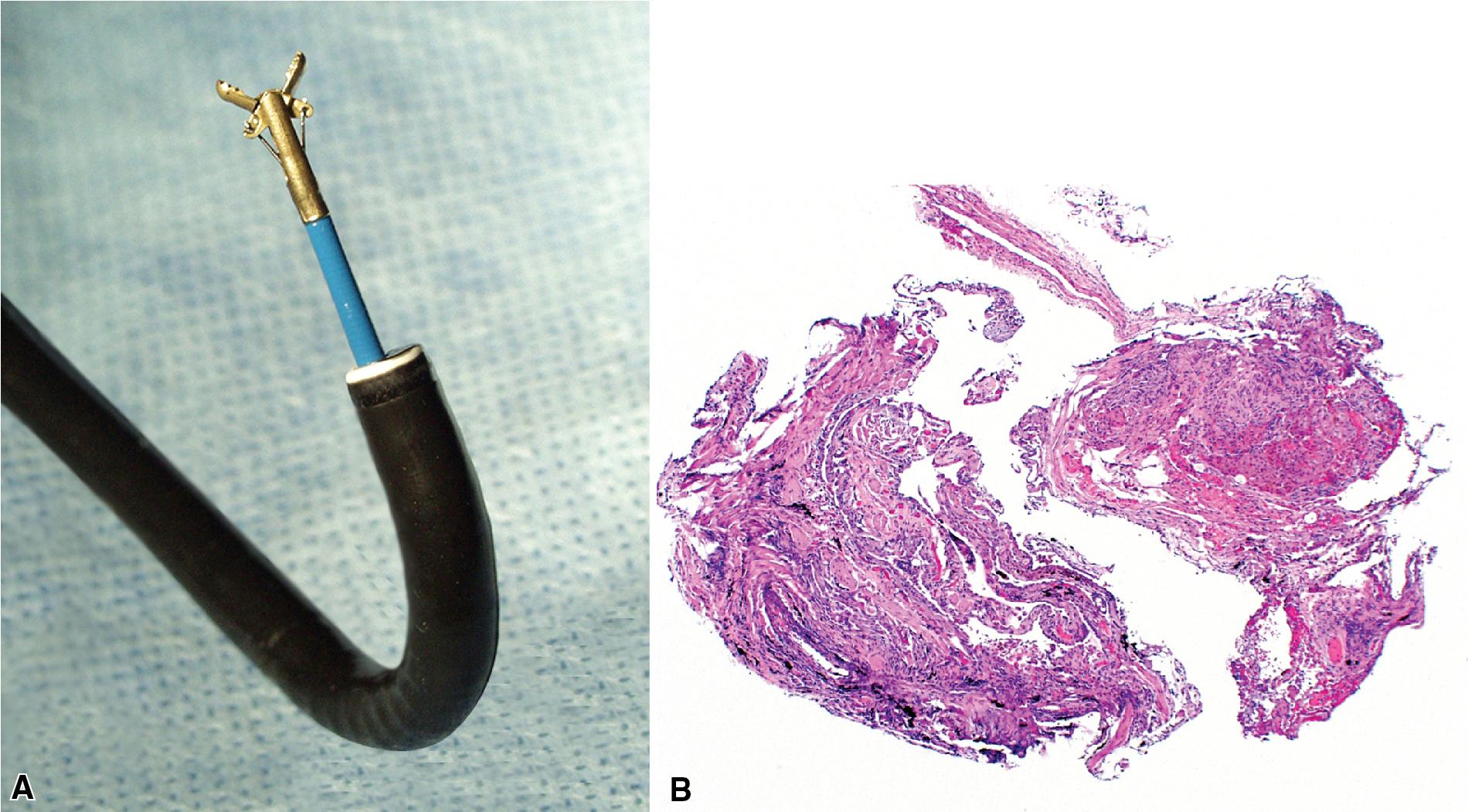
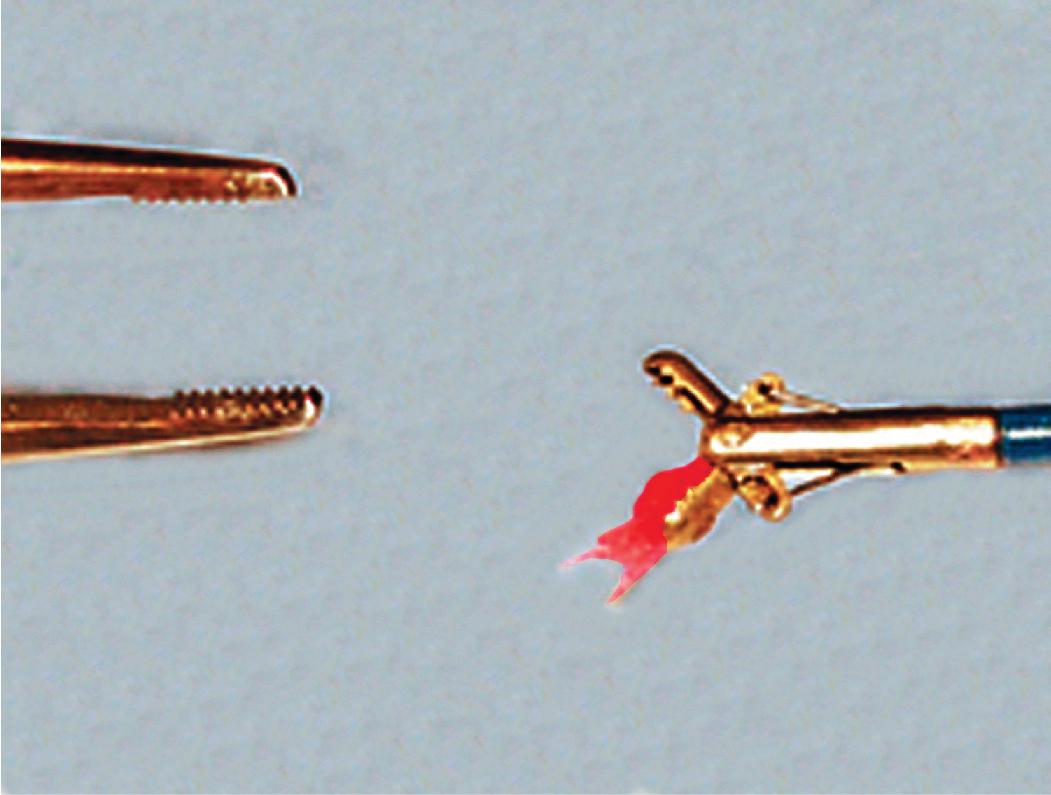
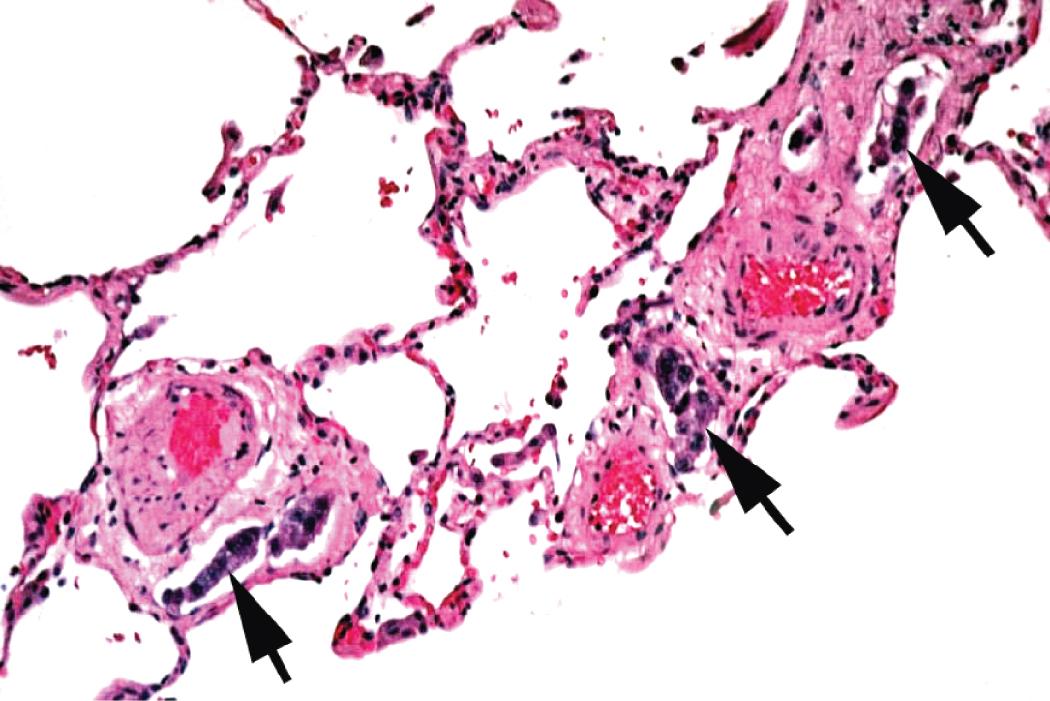
To avoid drying, specimens should be placed immediately into fixative solution or other transport medium. Immediate agitation of the samples in the solution vial helps to reexpand any crush artifact induced by the biopsy procedure, and, if done in a carrying medium, the supernatant can be aliquoted and sent for cytopathologic evaluation or special studies (e.g., immunocytochemistry studies, molecular genetic analysis). When these solutions are not available in the bronchoscopy suite or at the bedside, specimens can be placed in a closed container on a sterile, saline-soaked, nonstick wound dressing pad and transferred to the laboratory for processing, after the bronchoscopy is completed. Gauze or mesh pads are not appropriate for transport because the tissue may become entwined in the mesh material, making extraction difficult and tissue damage likely. As with all small, freshly obtained biopsy specimens, caution must be exerted to avoid prolonged exposure to air because drying artifact can render the specimen uninterpretable.
For tissue examination by light microscopy, the usual specimen fixation is accomplished using 10% neutral-buffered formalin (4% formaldehyde solution). Biopsies should be submersed in fixative, with an optimal fixative-to-specimen volume ratio of at least 10 : 1. For reasons of safety and disposal cost, some laboratories have replaced their formalin solutions with special nonaldehyde fixatives, most of which use alcohol as the primary fixing agent. Of note, all fixatives produce a certain degree of histologic artifact in tissues and cells, and these artifacts can influence the accuracy of the diagnosis. For this reason, it is essential that the pathologist responsible for interpreting the specimen be consulted regarding the type of fixative to be used. Despite some hazards in handling and disposal, 10% neutral-buffered formalin remains the standard agent for lung biopsy fixation.
For transferring bronchoscopic biopsy specimens from carrier or fixative solutions into cassettes for paraffin embedment, a useful device is a polystyrene pipette with the tip cut off with scissors ( Fig. 3.6 ). This pipetting device allows the operator to transfer delicate specimens without tearing or crushing. Transferring of these specimens using forceps is to be avoided.
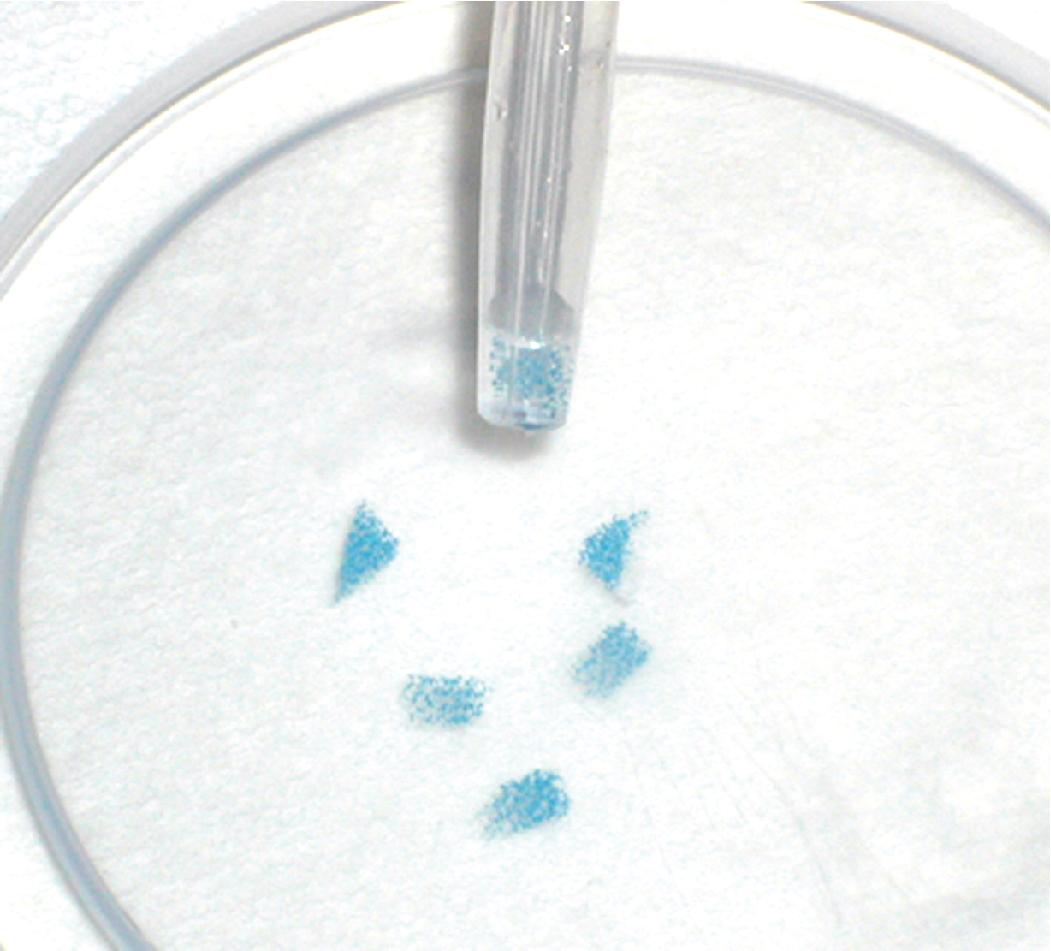
When infection is a consideration, bronchoscopic biopsy specimens can be transported directly to the microbiology laboratory for processing. , , In most scenarios, biopsy samples are sent for histopathologic evaluation and microbiologic studies directly from the bronchoscopy suite or bedside. For endobronchial and transbronchial samples, the optimal number of biopsy specimens varies depending on the radiologic distribution of disease, , bronchoscopy findings, , , and the specific diagnostic entities under consideration. , , As a general guideline, if the patient is tolerating the procedure well, the greater the number of biopsy specimens, the greater the likelihood of establishing a definitive diagnosis. , ,
In contrast with endobronchial biopsy, the transbronchial biopsy technique is intended to sample alveolar lung parenchyma beyond the cartilaginous bronchi. , , , This technique uses either crocodile-style (Machida) forceps or cupped forceps manipulated by the operator ( Fig. 3.7 ). To obtain the biopsy specimen, the forceps is advanced with the jaws closed into a distal airway until resistance is met. The forceps is retracted slightly and then advanced slightly, with the jaws open. The jaws are then closed, and the forceps is pulled out through the bronchoscope. Advancing the forceps at end-expiration can be helpful in forcing the bronchiolar wall and peribronchiolar lung parenchyma into the mouth of the device. The successful parenchymal biopsy specimen appears finely ragged ( Fig. 3.8 ) and usually measures between 2 and 3 mm in diameter. Following the transbronchial biopsy, the lung undergoes a repair process that includes fibroplasia similar to that seen in the setting of organizing pneumonia ( Fig. 3.9 ).
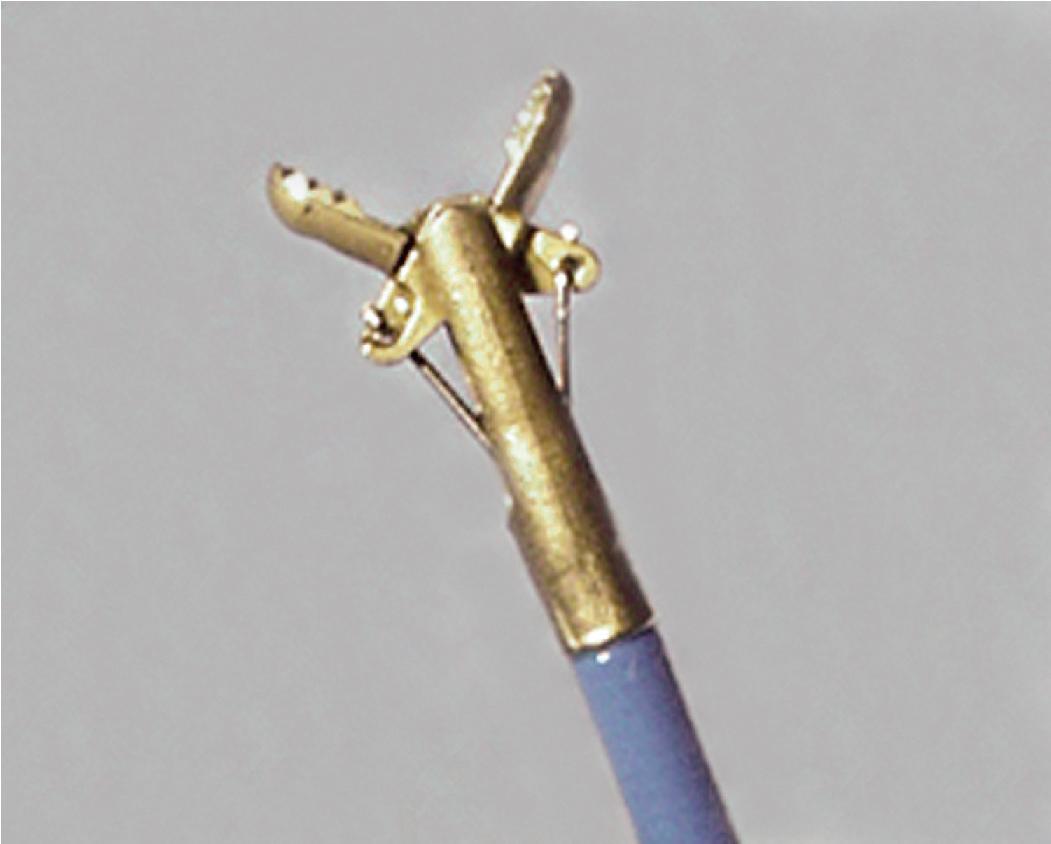
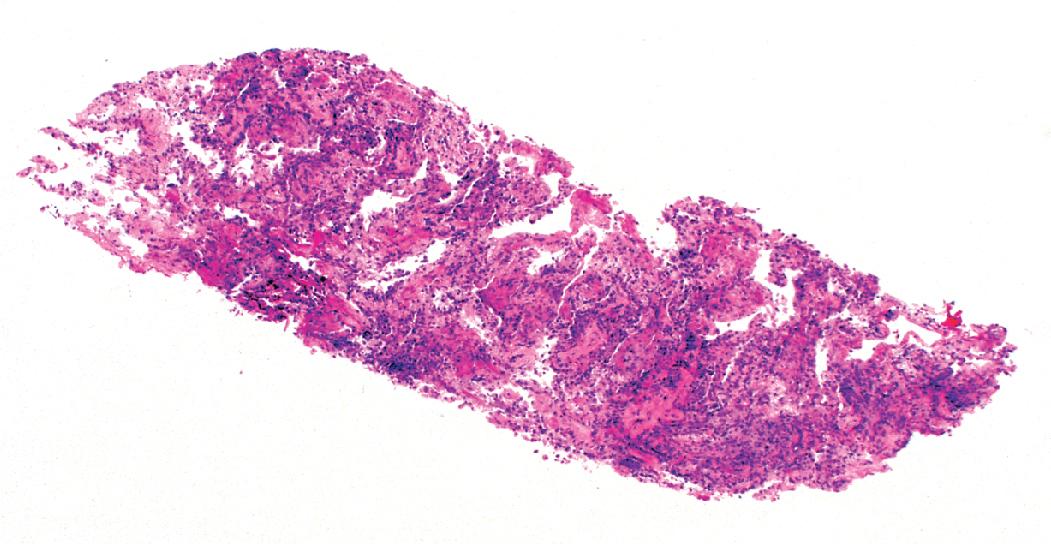
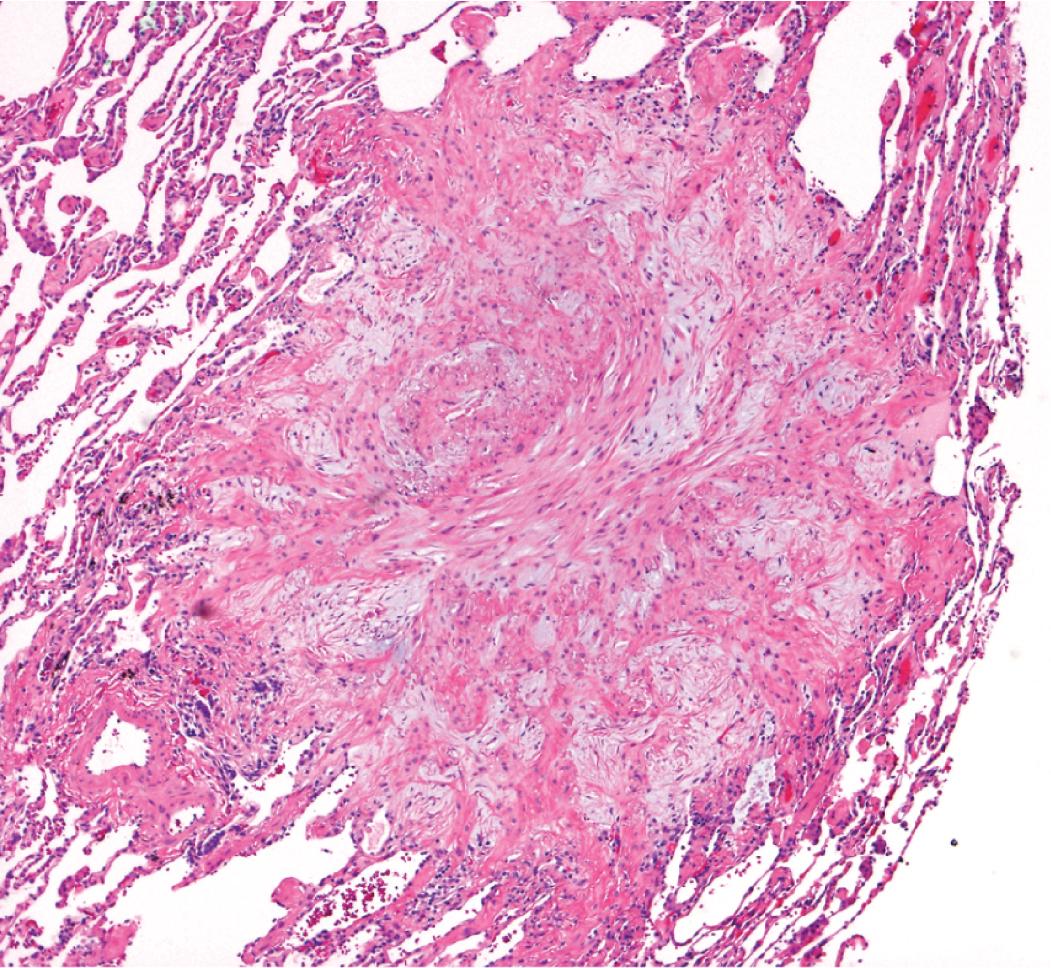
As with endobronchial samples, the transbronchial sample is teased from the forceps with a sterile needle, and the same precautions are advised to avoid damage during handling and transfer to fixative or other solution. The truncated pipette technique also is useful in this setting. Once processed, both types of biopsy specimens should be serially sectioned for thorough microscopic evaluation.
Several artifacts are encountered in the interpretation of transbronchial biopsies, including crush, bubbles, and sponge effects. Due to the acquisition of the specimen with cupped forceps, nearly all transbronchial forceps biopsies are at risk for crush artifact. It is usually seen at the edge of the specimen and consists of collapse of the alveolar walls ( Fig. 3.10 A). Bubble artifact occurs when air remains in the tissue while fixing in formalin. Formalin shrinks the tissue, and as it shrinks, the tissue is pressed against the residual air, creating artifactual holes in the tissue specimen, sometimes mistaken for lipoid pneumonia (see Fig. 3.10 B). Processing transbronchial biopsies in cassettes between sponges generates irregular larger holes in the tissue (see Fig. 3.10 C). Gentle handling of fresh tissue, agitation in formalin, and avoidance of sponges all can help in generating the optimal specimen for evaluation.
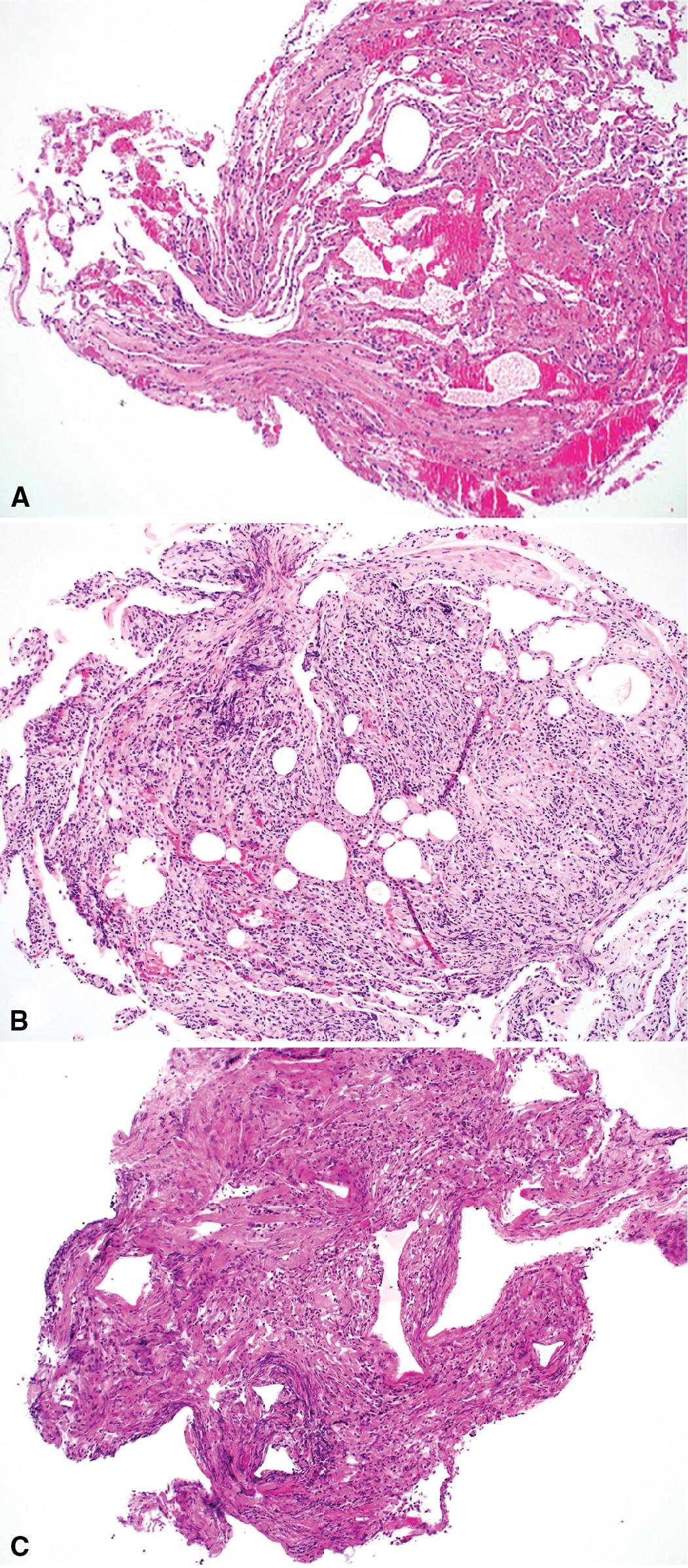
Cryobiopsy is a recently developed technique to obtain larger portions of lung tissue in an attempt to improve the yield of diagnostic tissue in lieu of an open surgical lung biopsy. Cryobiopsy is performed through the traditional flexible bronchoscope. The cryoprobe is advanced into the area of interest under fluoroscopy to between 1 and 2 cm from the pleural surface. Once in place, the cryoprobe is activated for 3 to 6 seconds. After tissue freezing, the cryoprobe and the bronchoscope are swiftly pulled from the patient. The bronchoscope must also be removed because the cryoprobe with frozen tissue is too large to remove through the working channel of the bronchoscope. Some centers have a second bronchoscopist ready to quickly return to the biopsy site to assess for bleeding. The biopsy is then thawed in saline and then gently placed in formalin ( Fig. 3.11 A). Each biopsy specimen is often greater than 5 mm, and complete pulmonary lobules are often sampled. This procedure is repeated 3 to 5 more times.
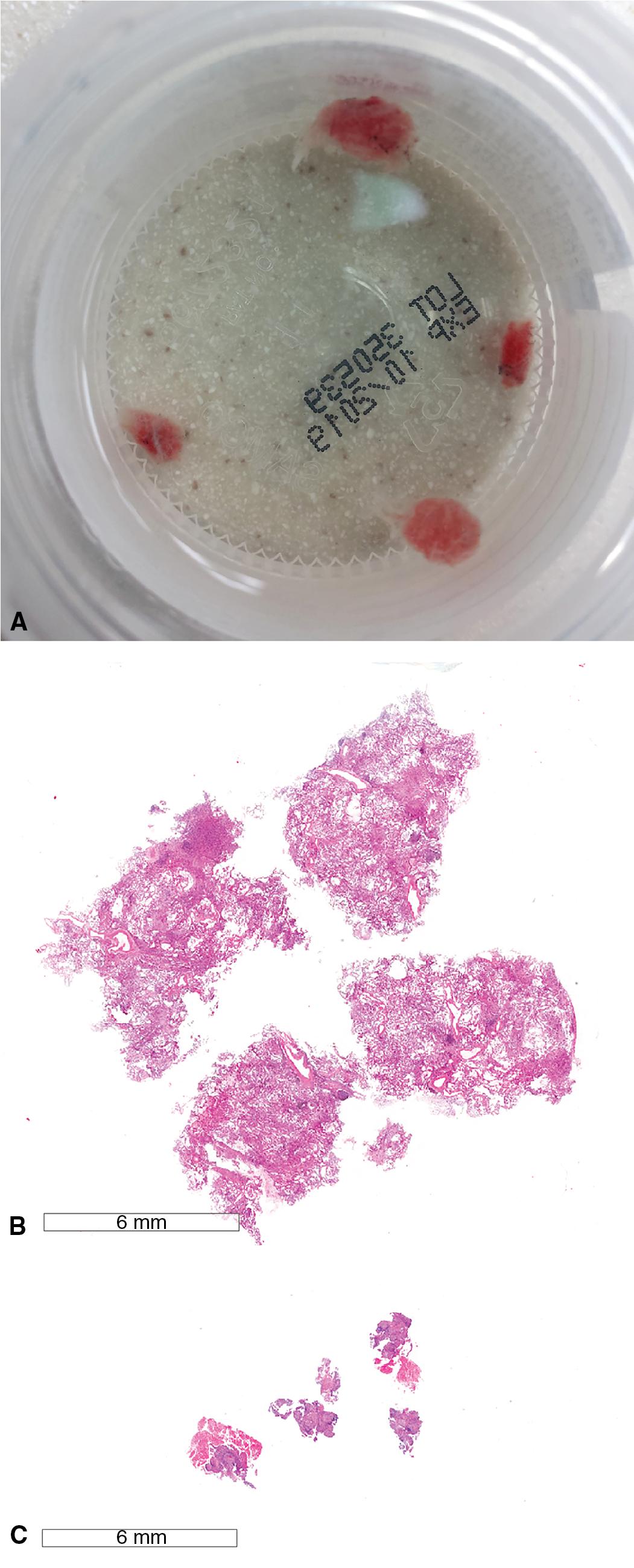
The main histologic benefits of cryobiopsy are larger specimen sizes and lack of crush artifact ( Fig. 3.11 B and C). Freezing artifact has not been a problem, likely due to the rapid speed of tissue freezing. Several studies have documented the usefulness of cryobiopsy in the setting of diffuse lung disease, with confident diagnoses obtained in more than 75% of cases in some studies. The rate of pneumothorax is variable but may be as high as 28%. Other studies have shown no significant difference in adverse outcomes (bleeding, pneumothorax) when comparing cryobiopsy to traditional transbronchial biopsy.
The overall usefulness of cryobiopsy was rigorously evaluated with two large trials in which paired cryobiopsy and surgical lung biopsy were performed on the same patient during the same anesthesia setting. , Unfortunately, the results from the trials were conflicting. The COLDICE trial investigated paired cryobiopsy and surgical lung biopsies from 65 patients and found a high level of agreement between histologic diagnosis and multidisciplinary diagnosis. Alternatively, a study from two centers in Italy showed poor concordance between cryobiopsy and surgical lung biopsy histologic interpretation in 21 patients with paired biopsies. CHEST released a clinical practice guideline suggesting cryobiopsy was safer than surgical lung biopsy, had a similar contribution to multidisciplinary diagnosis as surgical lung biopsy, but had less diagnostic yield. It is important to note that the diagnostic yield for transbronchial cryobiopsy is highly dependent on the operator of the cryoprobe procedure. The common scenario in which the diagnostic yield is not what might be expected for cryobiopsy is when the cryoprobe is not frozen for a sufficient period of time. In this setting, the pathologist is left with only a thin sheath of the bronchiolar mucosa with no more alveolar parenchyma than a traditional transbronchial biopsy. The usefulness of cryobiopsy remains an area of active research.
Visualized lesions of the airway epithelium can be sampled for cytologic evaluation. , , The technique involves the use of a conical bristle brush ( Fig. 3.12 ). Under direct visualization, the brush is agitated against the mucosal surface of the airway, forcing cells into the interstices of the bristles ( Fig. 3.13 ). The brush is removed from the bronchoscope and can be applied directly to glass slides. Cells and secretions smeared on slides can be immediately fixed for cytologic evaluation using the Papanicolaou staining method or air-dried for use with the Wright-Giemsa staining technique (this choice is best made in consultation with the pathologist). Immediate fixation of slides is best accomplished by direct immersion in 95% alcohol immediately after smearing of the sample on the slide. Each fixation and staining technique produces characteristic artifacts, and the use of one over the other depends on operator training and preference.
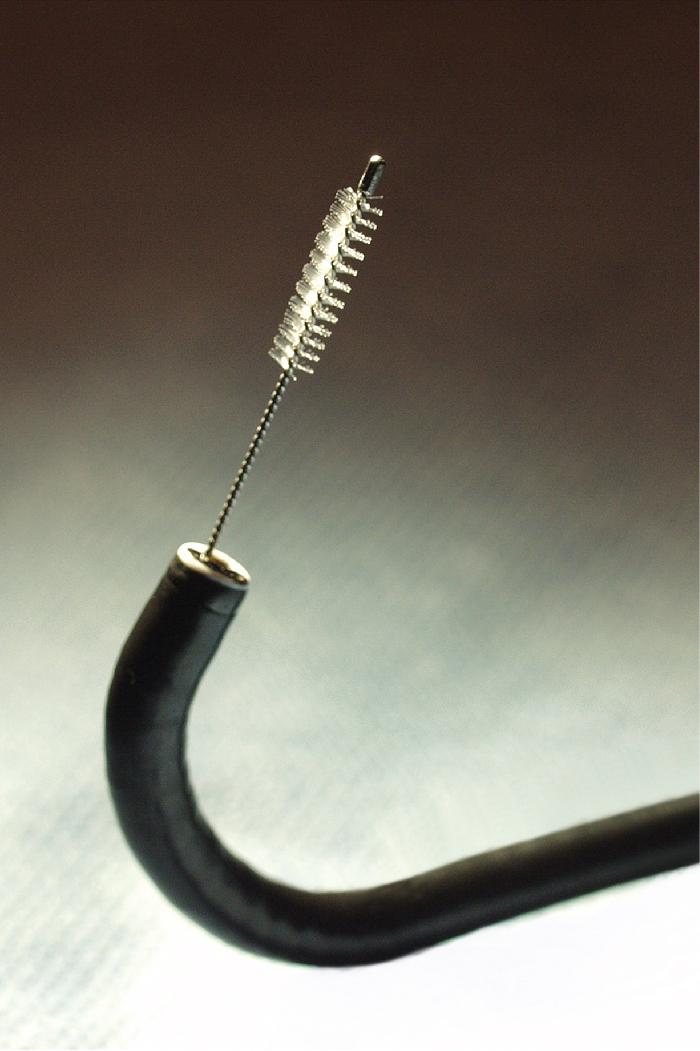
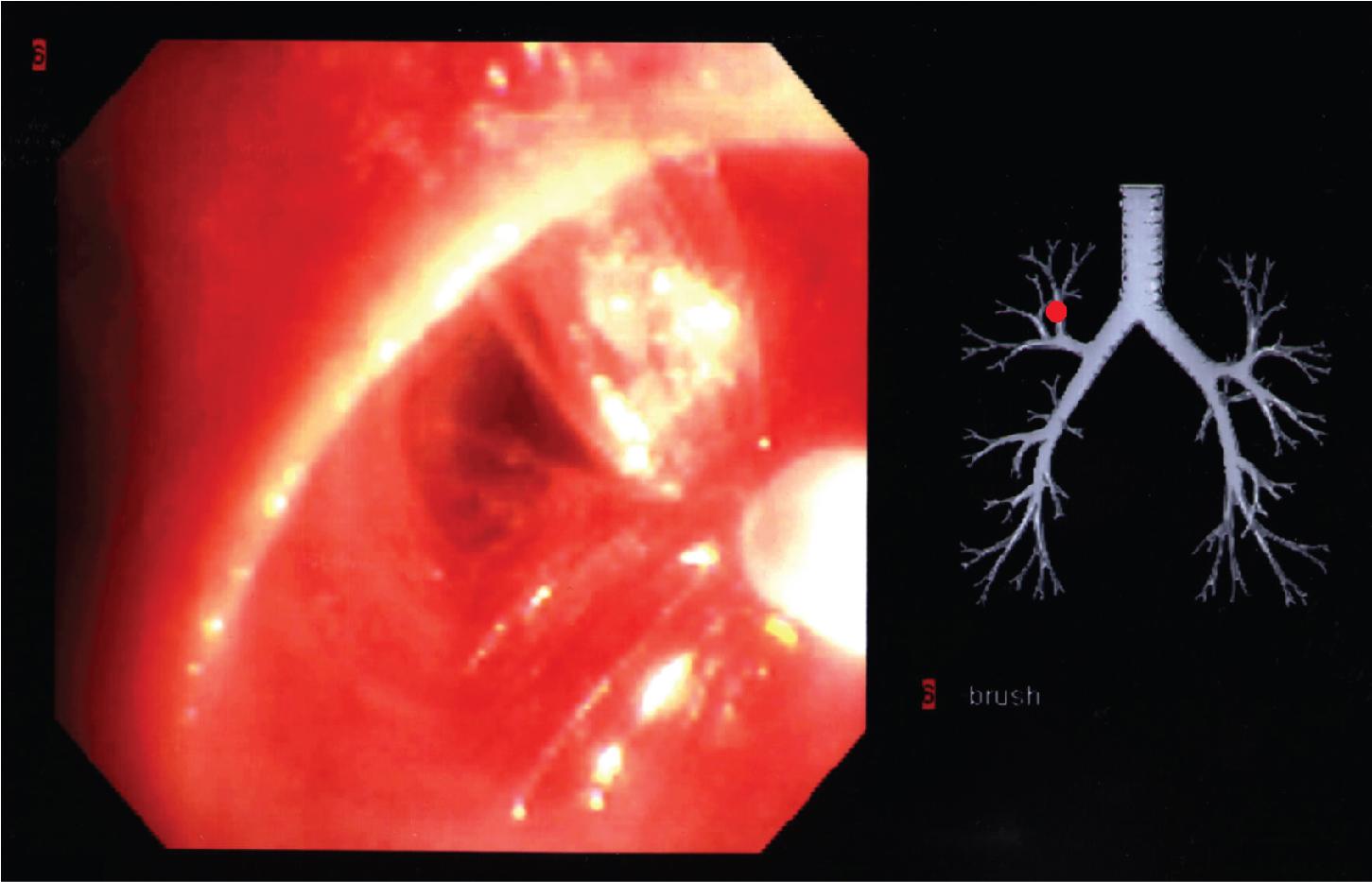
If slides are not available for smear preparations, the brush can be cut off and placed directly into a small vial of sterile saline, which is then shaken vigorously to dislodge cells into the fluid. This fluid sample of suspended cells is sent to the laboratory for Millipore filtration or cytocentrifuge-type application onto slides, , , , , analogous to the handling of washings and lavage specimens, discussed next. With ever-increasing demands for molecular genetic information for use in patient management (typically in the setting of malignant tumor), aliquoting this liquid suspension of cells and saving a portion of it in collaboration with the local pathologist is advisable and may avoid the need for resampling of tumor in cases in which surgical tumor removal is not an option.
Become a Clinical Tree membership for Full access and enjoy Unlimited articles
If you are a member. Log in here